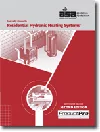Aug. 3, 2007 - Residential/nonresidential job, spending gaps widen; material, wage cost rises slow
Nonfarm payroll employment rose by 92,000, seasonally adjusted, in July, little more than one-half of the 151,000 (1.4%) monthly average over the past 12 months, the Bureau of Labor Statistics (BLS) reported. The unemployment rate, 4.6%, remained in the same narrow 4.4-4.6% range as in the past 10 months.
Construction employment fell 12,000 to an 18-month low of 7,650,000, down 0.7% from July 2006. However, the three nonresidential categories-building, specialty trade contractors, and heavy and civil engineering construction-added 64,000 jobs (1.5%) over 12 months. That figure was swamped by a decline of 117,000 (3.4%) in residential building and specialty trades employment. In fact, the swings may be greatly understated, because many employees of ‘residential’ specialty trade contractors are actually working on commercial projects but their firms still are counted in their former industry. If residential employment has actually fallen as much as spending (16% in the 12 months through June-see below), another 400,000 workers (one out of six residential specialty trade employees) should be reclassified as nonresidential, boosting that sector’s job growth to 11%.
Construction spending in June totaled $1.175 trillion at a seasonally adjusted annual rate, down 0.3% from the revised May estimate and 2.4% from the June 2006 level, the Census Bureau reported. For the first six months of 2007 combined, spending was down 3.5% from the first half of 2006. Private residential spending fell 0.7% for the month, 16% compared to June 2006, and 18% year-to-date (YTD). Private nonresidential spending climbed 0.3% in June, 17% compared to June 2006, and 18% YTD. Public spending was virtually unchanged for the month, up 10% from June 2006, and 11% higher YTD.
Among private categories, lodging construction continued as the standout, soaring more than 3% in June and 60% YTD. Office construction posted a 1.2% gain for the month and 25% YTD. Power construction surged 20% YTD, although June was down 0.2% from May’s total. Multi-retail (“big box” and other general merchandise stores, shopping centers and malls) tacked on 1.5% in June and 21% YTD. Of the two leading public categories, highway and street construction slumped 1.1% in June but was up 6.4% YTD, and educational construction fell 0.6% in June but rose 10% YTD. New single-family construction fell 1.4% in June, the 16th straight monthly decline, and was down 27% YTD. New multi-family construction rose 0.6% in June but was off 1% YTD.
Two private surveys, plus BLS data, point to continuing growth in nonresidential construction. The Institute for Supply Management (ISM) reported that nonmanufacturing purchasing executives said business activity increased in July, but by a narrower margin than in June. Construction was listed fifth among nine industries that reported higher activity; six reported lower activity and two had no change. New orders rose at 10 industries and order backlogs grew at six, including construction (fifth in both lists).
On July 23, the National Association for Business Economics (www.nabe.com) reported that respondents to its quarterly industry survey said there was a sharp rise (from 8% in April to 29% in July) in firms that expect to increase capital expenditures for structures over the next 12 months.
The BLS employment report showed an increase in July for the 42nd straight month in architectural and engineering services employment (a precursor to construction work), but at a slower pace; June’s rise was only half as great as in June 2006.
ISM reported the results of its monthly manufacturing purchasing executives survey on Wednesday. Respondents to both surveys reported input prices rose on balance, but not as commonly as in past months. Among inputs relevant to construction, respondents listed aluminum, building materials, copper-based products and fittings, lumber, and stainless steel as being up in price; flat-rolled steel was down in price; and diesel fuel was on both lists. Construction services/contractors were listed as being in short supply.
Total compensation costs (wages, salaries and employer costs for benefits) for nonfarm private and state and local employees increased 0.9%, seasonally adjusted, in the second quarter, about the same as in the previous four quarters, BLS reported. Construction compensation also rose 0.9%, down from 1.2% in the first quarter of 2007 and 1% in the fourth quarter of 2006. The rise in wages and salaries slowed to 0.8% in the second quarter from 1.1% in the first quarter for all employees and 1.3% for construction.
New orders from U.S. manufacturers (excluding semiconductor manufacturing) climbed 0.6%, seasonally adjusted, in June, but were 0.7% lower YTD than in the first half of 2006. Orders for construction materials and supplies rose 0.5% in June but fell 3.3% YTD. Orders for construction machinery, an often-volatile series, leaped 23% in June but were down 31% YTD.
In June, 303 metropolitan areas reported year-over-year increases in nonfarm payroll employment, 58 reported decreases and six had no change, BLS reported. The largest percentage rises were in Gulfport-Biloxi, Miss., 8.2%; Provo-Orem, Utah, 5.7%; Iowa City, Iowa, 5.4%; and El Centro, Calif., 5.3%.
Looking for a reprint of this article?
From high-res PDFs to custom plaques, order your copy today!






